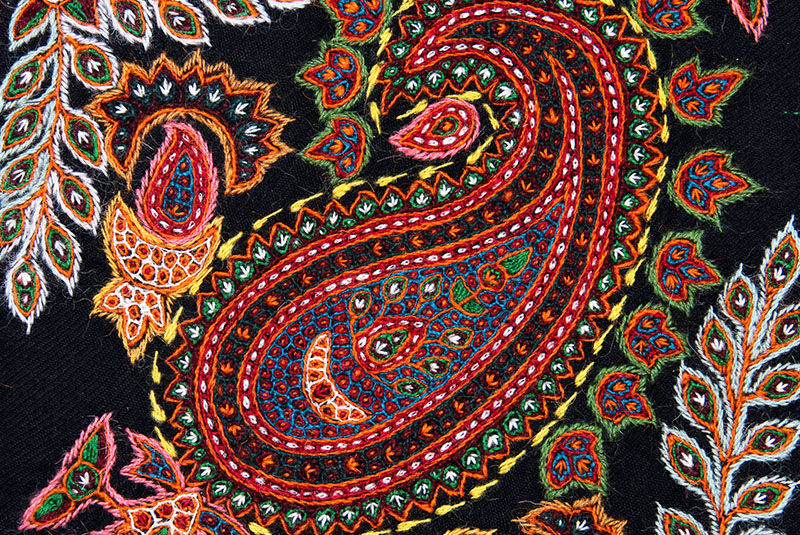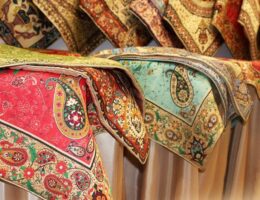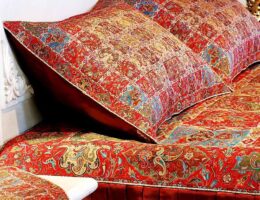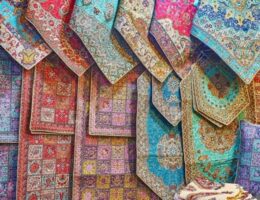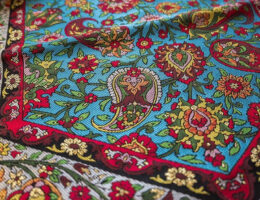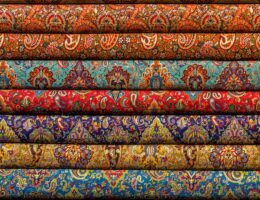IRAN ART EXHIBITION: WHAT IS PATEH HANDICRAFT?
Pateh is one of the traditional arts, which is specific to Kerman, Southeast of Iran.
Kermani women use colorful threads on a wide piece of cloth, which they call “Ariz (meaning “wide” in Persian)” to make this scarf which is then decorated with very beautiful designs.
Pateh Kerman Tree, aigrette, pine, peacock, cypress, and armband are major patterns which are used to weave patehs. Pateh is woven in various types and sizes, including a size suitable to be used by brides to put their things in it. Some of them are big enough to be spread at tables, to decorate them.
Pateh is a kind of Iranian needle-works. Color and weven strings are sewed in the wide cloth are Shawl in the designs of Bute, Sarv and Toranj which created beautiful designs that are the result of endeavor of hard-working girls and woman of Kerman.
Pateh consists of two parts; the background of the Shawl named Ariz and the colorful and wooly spinners that called Pateh. Both cloth and spinner are wooden and provided in different colors. Pateh is made only in Kerman moreover; sewing Pateh is current in all township and villages around Kerman province particularly in Sirjan and Rafsanjan.
These designers have root in the Iranian culture and civilization. One of the most beautiful “Patehs” which has a unique sewin is the cover of the renowned Iranian mystic and poet, Shah Nematollah Vali tomb in Kerman’s town of Mahan. It has been sewed in 1285 Ah. It is the result of two year enduring work of sixteen woman of Kerman on a cloth at 355cm in length and 210cm in width. Of course there are other samples of this art throughout Kerman.
Pateh (Farsi: پته ), or pateh-duzi is a style of Iranian embroidery, in particular from Kerman province in the southeast. It may be linked to local carpet weaving, and many of the embroidered designs recall carpet motifs, such as the toranj (bergamia), sarv (cypress) and the buteh (paisley), but also the sun.
Characteristically, the borders of a pateh are filled with floral or paisley designs. Sometimes the arch of a mihrab is depicted at the top. The embroidery is carried out by women who use richly coloured, woollen threads stitched onto a (mostly) woollen and reddish ground material (ariz or shal), generally a twill weave. The threads for the embroidery are dyed with henna, madder, pomegranate, or walnut husks; whether this is till the case is unknown.
Some highly trained embroiderers would follow the lines of the twill weave and create an embroidered product that could easily be mistaken for a textile with woven decorations.
IRAN ART EXHIBITION: The aksi (‘mirror’) technique involved the splitting of the warp threads and thus creating a mirror image of the embroidered design on the reverse of the cloth.
The embroidery patterns are indicated by charcoal dust and the pouncing technique. The charcoal lines are often further accentuated with a pen.
An early twentieth century pateh (355 x 210 cm) is kept in the museum of Mahan in Kerman province, some thirty km southeast of the provincial capital, Kerman. The pateh dates to 1294 of the Iranian Islamic calendar (AD 1915). It was dedicated to the shrine, at Mahan, of the local Sufi saint, Shah Nimatullah Wali (d. 1431).
Pateh embroidery from Kerman province was especially known from the towns of Rafsanjan and Sirjan. Nowadays some pateh embroiderers are still active in the village of Hudk.
Pateh duzi is a type of embroidery art typical of the city of Kerman, southeastern province of Kerman. The fabric is thick and wool and is called ariz (which in Farsi means wide).
Those who dedicate themselves to this art are mostly girls or housewives who with the help of a needle create imaginary drawings inspired by their thoughts and personal fantasies through dots with colored threads against the background of a thick woolen fabric.
Pateh duzi is one of the most beautiful and ancient traditional embroidery arts of Iran that has its deep roots in the ancient cultural history of Kerman. The fabric used possesses a delicacy and a particular beauty and is covered with delicate embroideries. Only next to the sewn designs remains a very small space of the background without embroidery and sometimes even the whole background is embroidered so that it seems that it no longer exists.
On average to sew a meter of pateh it takes about 4,000 grams of thread. The seam of the lines drawn in the shawl is complete and is the same as the sāghe duzi (type of floral embroidery); for the red fabrics the seam line is black, while for the white fabric the line is yellow.
After the seam of the outline is finished and the main lines of the design have been embroidered, the interior is filled with a particular method of embroidery. This seam is usually present between the narrow marginal parallel lines and is filled with a different seam. The leaf color is used in white, black, crimson, green and light blue pateh.
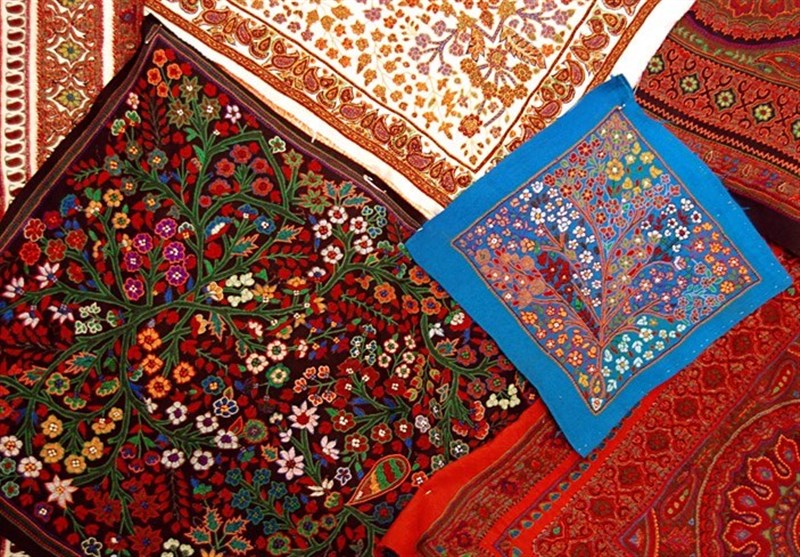
IRAN ART EXHIBITION: After seaming, the pateh is left in cold water where detergent has been put in for a short time, then it is rubbed a little and is washed several times until the water is completely clear. After it has released all the water, it is left to dry and is ironed. Usually with the embroidered pateh objects are prepared such as: The cover of holy Qur’an, the prayer mat, types of decorative paintings, and tablecloths (small and for the dining table and the coffee table.
Pateh Doozi is an Iranian traditional needlework folk art, which originated in and is associated mainly with Kerman province, where it is produced by women.
Pateh Doozi consists of woolen fabric or shawl called ‘Ariz’ and the embroidery threads, which as usually made of the same woolen yarns.
Sirjan is also considered one of the centers of Iranian handicrafts. By combining different and new designs, Pateh Doozi will be introduced to tourists more than once before. In the past, Pateh Doozi was used in a few cases, but today it is used in other crafts such as clothes, shawls, bags, shoes.
